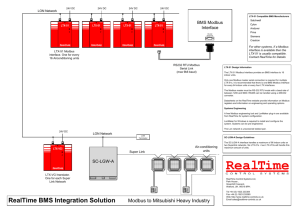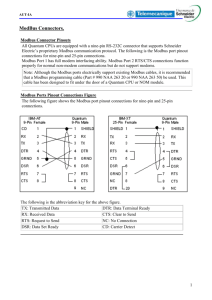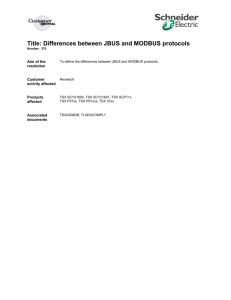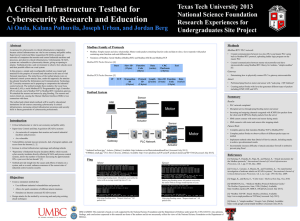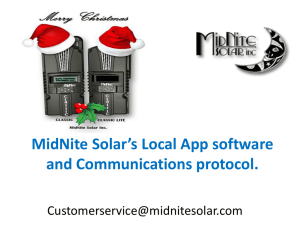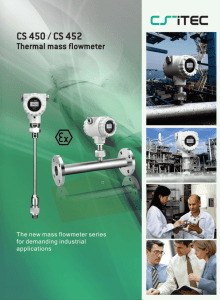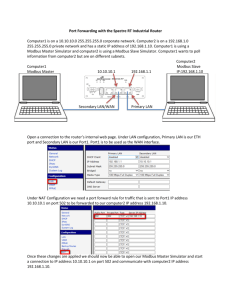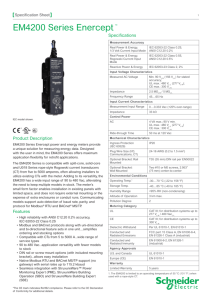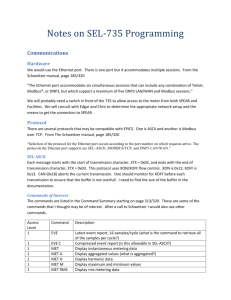SYNC-MODB REV J_BURNER DOOR TEMP.indd
advertisement
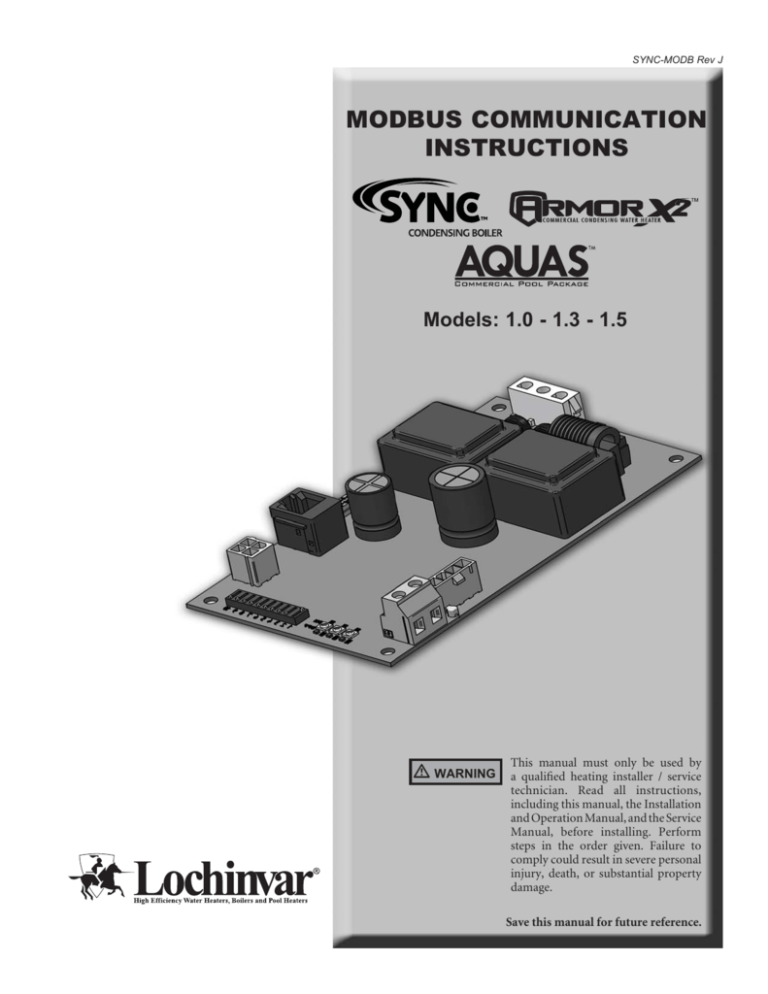
SYNC-MODB Rev J MODBUS COMMUNICATION INSTRUCTIONS Models: 1.0 - 1.3 - 1.5 WARNING This manual must only be used by a qualified heating installer / service technician. Read all instructions, including this manual, the Installation and Operation Manual, and the Service Manual, before installing. Perform steps in the order given. Failure to comply could result in severe personal injury, death, or substantial property damage. Save this manual for future reference. Contents 1. INTRODUCTION Definitions .................................................................... Minimum System Requirements.................................. 2. CONFIGURATION Addressing ................................................................... Timing Specifications ................................................... Parity............................................................................ Data Transmission Mode............................................. Modbus Board Diagnostics.......................................... Internal Faults......................................................... Modbus Function Set ............................................. Modbus Exception Codes............................................ 1 2 2 3 4 4 4 4 4 5 6 3. MEMORY MAP Primary Data Tables .................................................... . 7 Appliance Map ............................................................. 7-8 Input Registers ....................................................... . 8 Holding Registers ................................................... . 8 Configuration Bits ........................................................ . 8 4. WIRING REQUIREMENTS Physical Wiring ............................................................ . 9 Typical System Wiring ............................................ 12-13 5. UNIT OPERATION Unit Operation with Modbus Communications ...... 14-17 6. TROUBLESHOOTING........................................... 18-19 7. DIAGRAMS Ladder Diagram Part 1 & 2 .................................... 20-21 Wiring Diagram ............................................................ 22 Revision Notes ................................................... Back Cover Introduction The information contained in this manual provides general guidelines for the implementation of Modbus communication with the Lochinvar appliance. All Modbus networks are implemented utilizing a master-slave arrangement where all appliances are slaves and the master is a building automation system capable of communicating over a RS-485 serial connection. Definitions Abbreviation or Acronym Meaning ASCII American Standard Code for Information Interchange BAS Building Automation System Baud (Baud Rate) Number of data bits transmitted per second (bps) EMS Energy Management System FDX Full-Duplex HDX Half-Duplex Hex Hexadecimal Number (0 - 9, A - F) I/O Box Input/Output (I/O) LSB Least Significant Byte Modbus® A serial, half-duplex data transmission protocol developed by AEG Modicon MSB Most Significant Byte RS232 A standard for serial, full-duplex (FDX) transmission of data based on the RS232 Standard RS485 A standard for serial transmission of data based on the RS-485 Standard RTU Remote Terminal Unit Minimum System Requirements • BAS system or computer with a serial or USB port with a converter to RS-485. • Appliance equipped with Modbus communication board. • Shielded twisted pair communication cable. 2 Modbus Instructions 2 Configuration The Modbus communication board is equipped with a set of ten dip switches that are used to set the board configuration (address, baud rate, and parity settings). The first eight are used to set the address of each board. The ninth baud rate. The tenth is parity. Figure 2-1_Modbus Communication Board DIP SWITCHES LED’S Addressing The Modbus addressing space is comprised of 256 different addresss. • 0 is reserved for broadcast messages from the master device • 1 - 247 are free to use for each unique device • 248 - 255 are reserved To set the Modbus address the dip switches can be set in either the 0 position or the 1 position. For switches set to the 1 position their value will be added together to determine the address. For each switch set to the 1 position it has the following value: Example: To set the address of the Modbus board to 50, dip switches 2, 5, and 6 have to be set to the 1 position. The address is determined by adding the values of all the dip switches together. Address = Value of Dip switch 1 + Value of Dip switch 2 + Value of Dip switch 3 + Value of Dip switch 4 + Value of Dip switch 5 + Value of Dip switch 6 + Value of Dip switch 7 + Value of Dip switch 8 In this example: Address = 0 + 2 + 0 + 0 + 16 + 32 + 0 + 0 = 50 Dip switch 1 = 1 Dip switch 2 = 2 Dip switch 3 = 4 Dip switch 4 = 8 Dip switch 5 = 16 Dip switch 6 = 32 Dip switch 7 = 64 Dip switch 8 = 128 Any dip switch set to 0 has a value equal to 0. 3 Modbus Instructions 2 Configuration Timing Specifications Data Transmission Mode The baud rate for the Modbus board is selectable with Dip switch #9. Many Modbus bus master devices can be configured to transmit data in either Modbus RTU or Modbus ASCII modes. Since RTU messages can be formatted to use fewer data bits and are therefore more efficient, RTU has been chosen to be used with all Lochinvar Modbus communication. Please ensure that the master device is transmitting Modbus RTU. 1 = 19200 bps 0 = 9600 bps Each message is started by at least 3.5 character times of silence. The maximum delay between frames is 1.5 character times. When the system temperature and/or tank temperature is provided by the BAS to the boiler or water heater, it is critical that the temperature be updated every few seconds. If the appliance does not receive updated temperatures within a timeout period (installer adjustable), the control will revert to using its own sensor inputs (if sensors are connected). The timeout is programmable by pressing the MAIN>>SETUP>>BMS buttons. The timeout is adjustable between 5 and 120 seconds. The default timeout is 10 seconds. When the BAS is not providing either of these temperatures, but is still controlling the boiler or water heater (such as providing a modulation command), the BAS must refresh these commands at least every 4 minutes. If the commands are not refreshed, the appliance will revert to operating based on its own inputs. Parity Parity is set by the position of Dip switch #10. 0 = No Parity 1 = Even Parity If No Parity is selected there will be two stop bits, otherwise there will be one. 4 Modbus Board Diagnostics The Modbus board is equipped with three LED’s for visual diagnostics: Two yellow LED’s and one green. One yellow LED (D5) is used to indicate reception of data. The other yellow LED (D6) is used to indicate transmission of data. The green LED (D7) is used to show internal faults. Internal Faults: Normal Operation = 1 second on, 1 second off Controller Fault = Continuously on No Burner Control Communication = 0.5 seconds on, 1.5 seconds off No Modbus Communication = 1.5 seconds on, 0.5 seconds off Modbus Communication The Modbus communication commands and exception codes that are supported by the Modbus communication board can be found on pages 5 and 6 of this manual. Modbus Instructions 2 Configuration (continued) Modbus Function Set Function Sub Function Dec HEX Description Dec HEX 1 01 Read Coil Status 2 02 Read Input Status 3 03 Read Holding Registers 4 04 Read Input Registers 5 05 Force Single Coil 6 06 Preset Single Register 7 07 Read Exception Status 8 08 0 00 Diagnostic - Return Query Data 1 01 Diagnostic - Restart Communication 2 02 Diagnostic - Return Diagnostic Register 4 04 Diagnostic - Force Listen Mode 10 0A Diagnostic - Clear Counters and Diagnostic Registers 11 0B Diagnostic - Return Bus Message Count 12 0C Diagnostic - Bus Communication Error Count 13 0D Diagnostic - Bus Exception Error Count 14 0E Diagnostic - Return Slave Message Count 15 0F Diagnostic - Return Communication Error Count 16 10 Diagnostic - Return Slave NAK Count 17 11 Diagnostic - Return Slave Busy Count 18 12 Diagnostic - Return Bus Character Overrun Count 20 14 Diagnostic - Clear Overrun Counter and Flag 11 0B Get Communication Event Counter 12 0C Get Communication Event Log 15 0F Write Multiple Coils 16 10 Write Multiple Registers 17 11 Report Slave ID 23 17 Read / Write Multiple Registers 5 Modbus Instructions 2 Configuration Modbus Exception Codes MODBUS Exception Codes Code Name Meaning ILLEGAL FUNCTION The function code received in the query is not an allowable action for the server (or slave). This may be because the function code is only applicable to newer devices, and was not implemented in the unit selected. It could also indicate that the server (or slave) is in the wrong state to process a request of this type, for example because it is unconfigured and is being asked to return register values. ILLEGAL DATA ADDRESS The data address received in the query is not an allowable address for the server (or slave). More specifically, the combination of reference number and transfer length is invalid. For a controller with 100 registers, the PDU addresses the first register as 0, and the last one as 99. If a request is submittted with a starting register address of 96 and a quantity of registers of 4, then this request will successfully operate (address-wise at least) on registers 96, 97, 98, 99. If a request is submitted with a starting register address of 96 and a quantity of registers of 5, then this request will fail with Exception Code 0x02 “Illegal Data Address” since it attempts to operate on registers 96, 97, 98, 99 and 100, and there is no register with address 100. 03 ILLEGAL DATA VALUE A value contained in the query data field is not an allowable value for server (or slave). This indicates a fault in the structure of the remainder of a complex request, such as that the implied length is incorrect. It specifically does NOT mean that a data item submitted for storage in a register has a value outside the expectation of the application program, since the MODBUS protocol is unaware of the significance of any particular value of any particular register. 04 SLAVE DEVICE FAILURE An unrecoverable error occurred while the server (or slave) was attempting to perform the requested action. 05 ACKNOWLEDGE Specialized use in conjunction with programming commands. The server (or slave) has accepted the request and is processing it, but a long duration of time will be required to do so. This response is returned to prevent a timeout error from occurring in the client (or master). The client (or master) can next issue a Poll Program Complete message to determine if processing is completed. 06 SLAVE DEVICE BUSY Specialized use in conjunction with programming commands. The server (or slave) is engaged in processing a long -- duration program command. The client (or master) should re-transmit the message later when the server (or slave) is free. MEMORY PARITY ERROR Specialized use in conjuction with function codes 20 and 21 and reference type 6, to indicate that the extended file area failed to pass a consistency check. The server (or slave) attempted to read record file, but detected a parity error in the memory. The client (or master) can retry the request, but service may be required on the server (or slave) device. 01 02 08 0A 0B 6 Specialized use in conjunction with gateways, indicates that the gateway was unable to allocate an internal communication path from the input port to the GATEWAY PATH UNAVAILABLE output port for processing as the request. Usually means that the gateway is misconfigured or overloaded. GATEWAY TARGET DEVICE FAILED TO RESPOND Specialized use in conjunction with gateways, indicates that no response was obtained from the target device. Usually means that the device is not present on the network. Modbus Instructions 3 Memory Map Primary Data Tables Table Data Type Read / Write Discrete Inputs Single Bit Read Only Coils Single Bit Read / Write Input Registers 16-Bit Word Read Only Holding Registers 16 Bit Word Read / Write Appliance Memory Map Coils Address 00001 00005 10001 10002 10003 10004 10005 10006 10007 10008 10009 10010 Description Default Unit Enable / Room Thermostat 1 / Stage 1 0 Tank Thermostat 0 Discrete Inputs Manual Reset High Limit 1 0 Flow Switch 1 0 Gas Pressure Switch 1 0 Louver Proving Switch 1 0 Air Pressure Switch / Flap Valve 1 0 Blocked Drain Switch 1 0 Auto Reset High Limit 1 0 Flame 1 0 Enable / Room Thermostat 1 / Stage 1 0 Tank Thermostat 0 Unit Min. Max. Resolution 1=ON / 0=OFF 0 1 1 1=ON / 0=OFF 0 1 1 1=ON 1=ON 1=ON 1=ON 1=ON 1=ON 1=ON 1=ON 1=ON 1=ON / / / / / / / / / / 0=OFF 0=OFF 0=OFF 0=OFF 0=OFF 0=OFF 0=OFF 0=OFF 0=OFF 0=OFF 0 0 0 0 0 0 0 0 0 0 1 1 1 1 1 1 1 1 1 1 1 1 1 1 1 1 1 1 1 1 10017 10018 10019 10020 10021 10022 10023 Manual Reset High Limit 2 Flow Switch 2 Gas Pressure Switch 2 Louver Proving Switch 2 Air Pressure Switch / Flap Valve 2 Blocked Drain Switch 2 Flame 2 0 0 0 0 0 0 0 1=ON 1=ON 1=ON 1=ON 1=ON 1=ON 1=ON / / / / / / / 0=OFF 0=OFF 0=OFF 0=OFF 0=OFF 0=OFF 0=OFF 0 0 0 0 0 0 0 1 1 1 1 1 1 1 1 1 1 1 1 1 1 10033 10034 10035 10036 10038 10039 Run-time Contacts Alarm Contacts 1 CH Pump 1 DHW Pump 1 Gas Valve 1 System Pump 0 0 0 0 0 0 1=ON 1=ON 1=ON 1=ON 1=ON 1=ON / / / / / / 0=OFF 0=OFF 0=OFF 0=OFF 0=OFF 0=OFF 0 0 0 0 0 0 1 1 1 1 1 1 1 1 1 1 1 1 10041 10042 10043 10046 Run-time Contacts 2 Alarm Contacts 2 CH Pump 2 Gas Valve 2 0 0 0 0 1=ON 1=ON 1=ON 1=ON / / / / 0=OFF 0=OFF 0=OFF 0=OFF 0 0 0 0 1 1 1 1 1 1 1 1 7 Modbus Instructions 3 Memory Map Appliance Memory Map Address 30001 30002 30003 30004 Description Discrete Inputs 1 - 16 Discrete Inputs 17 - 32 Discrete Inputs 33 - 48 System / Cascade Setpoint Input Registers Default Unit 0 NA 0 NA 0 NA 0 Degrees Celsius Min. 0 0 0 0 Max. 65535 65535 65535 130 Resolution 1 1 1 0,5 30006 30007 30008 30009 30010 30011 30012 Cascade Total Power Cascade Current Power Outlet Setpoint 1 Outlet Temperature 1 Inlet Temperature 1 Flue Temperature 1 Firing Rate 1 0 0 0 0 0 0 0 % % Degrees Celsius Degrees Celsius Degrees Celsius Degrees Celsius % 100 0 0 0 -20 -20 0 800 800 130 130 130 130 100 1 1 0,5 0,1 0,1 0,1 0,1 30014 30015 30016 30017 30018 30019 30020 30021 Unit 1 Status Code Unit 1 Blocking Code Unit 1 Lockout Code Outlet Setpoint 2 Outlet Temperature 2 Inlet Temperature 2 Flue Temperature 2 Firing Rate 2 0 0 0 0 0 0 0 0 NA NA NA Degrees Celsius Degrees Celsius Degrees Celsius Degrees Celsius % 0 0 0 0 0 -20 -20 0 65535 65535 65535 130 130 130 130 100 1 1 1 0,5 0,1 0,1 0,1 0,1 30023 30024 30025 Unit 2 Status Code Unit 2 Blocking Code Unit 2 Lockout Code NA NA NA 0 0 0 65535 65535 65535 1 1 1 40001 Configuration 0 NA 0 65535 1 40002 Coils 0 NA 0 65535 1 40003 0-10 Volt Input / Rate Command / Setpoint Command 0 % 0 100 1 40004 40005 40006 40007 Tank Setpoint Tank Temperature Outdoor Temperature System Supply Temperature 0 0 0 0 0 -20 -40 -20 87,5 130 60 130 0,5 0,1 0,1 0,1 0 0 0 Holding Registers Degrees Degrees Degrees Degrees Celsius Celsius Celsius Celsius Configuration Bits Address 40001 contains configuration bits sent from the BAS to the boiler or water heater. These bits tell the appliance to use its own internal inputs, or inputs from the BAS. When a bit is set to 1, the appliance will ignore the corresponding value contained internally, and expect the BAS to write that value into the Holding Registers. The configuration bits are as follows: Bit 0 (LSB): Unit Enable Bit 1: Tank Thermostat Bit 2: Rate Command / 10 - 10V Input / Setpoint Command Bit 3: Tank Setpoint 8 Bit 4: System Supply Temperature Bit 5: Outdoor Temperature Bit 6: Tank Temperature Bit 7: System Return Temperature Bit 8 - 15: Not Used (Default = 0) Modbus Instructions 4 Wiring Requirements Note that when the System Supply Temperature and/or the Tank Temperature are provided by the BAS, they need to be refreshed every few seconds. This is required in order to prevent unwanted fluctuations in these temperatures. If these values are not provided every few seconds (timeout is programmable), the boiler or water heater will revert to its own internal control. If neither of these temperatures is provided by the BAS, but any of the other control signals are being provided, the BAS will still need to refresh these inputs at least every 4 minutes. Physical Wiring RS-485 Communication Bus • Maximum Length = 4000 feet • Cable Specification = 24 AWG / A,B (twisted pair) and GND Shielded, with characteristic Impedance = 120 ohm • Maximum Load = 32 units (32 nodes) NOTE: Cable must be terminated with 120 ohm impedance matching resistor on each end. FROM PREVIOUS BOILER TANK SENSOR OUTDOOR SENSOR SYSTEM SENSOR ENABLING DEVICE TANK THERMOSTAT HEAT EXCHANGER 1 FLOW SWITCH HEAT EXCHANGER 2 FLOW SWITCH LOUVER PROVING SWITCH BUILDING MANAGEMENT SYSTEM SHIELD A B B A SHIELD A B SHIELD A B 23 OUT DOOR 24 SENSOR 25 TANK 26 SENSOR 27 SHIELD GND 28 B 29 A 30 SHIELD GND CASCADE TO NEXT BOILER SHIELD MODBUS COMMUNICATION BUS TO NEXT BOILER MOD BUS 21 SYSTEM 22 SENSOR LBL20052 REV B 15 SHIELD GND 16 A 17 B 18 SHIELD GND 19 (+) 0 - 10V INPUT 20 (-) 9 HEX 1 10 FLOW SWITCH 11 TANK 12 THERMOSTAT 13 R ENABLE 14 W 7 HEX 2 8 FLOW SWITCH 1 2 3 4 5 6 ALARM CONTACTS RUN TIME CONTACTS LOUVER PROVING Figure 4-1_Terminal Strip Connections 9 Modbus Instructions 4 Wiring Requirements Figure 4-2_Control Inputs SECONDARY SMART CONTROL MODULE LOW VOLTAGE CONNECTION BOARD PRIMARY SMART CONTROL MODULE SEQUENCER / BUILDING MANAGEMENT SYSTEM OUTDOOR SENSOR O-TEMP HEAT EXCHANGER SWITCH HW TANK SENSOR PRIMARY/SECONDARY INLET TEMPERATURE SENSOR SYSTEM SENSOR O-TEMP HEAT EXCHANGER SWITCH FLOW SWITCH BLOCKED DRAIN SWITCH HW THERMOSTAT ROOM THERMOSTAT / ZONE CONTROL PRIMARY/SECONDARY OUTLET TEMPERATURE SENSOR PRIMARY/SECONDARY FLUE GAS SENSOR LOW WATER CUTOFF TOUCH DISPLAY TOUCH PANEL INTERFACE PRIMARY/SECONDARY GAS PRESSURE SWITCH PRIMARY/SECONDARY HIGH LIMIT SENSOR PRIMARY/SECONDARY FLAME SENSOR PC INTERFACE DOOR TEMPERATURE SWITCH IMG00004 MODBUS COMMUNICATION BOARD 10 Modbus Instructions 4 Wiring Requirements (continued) Figure 4-3_Control Outputs LOW VOLTAGE CONNECTION BOARD SECONDARY SMART TOUCH CONTROL MODULE PRIMARY SMART TOUCH CONTROL MODULE ALARM BELL RUN TIME CONTACTS HEAT EXCHANGER 1 / HEAT EXCHANGER 2 BOILER PUMP SEQUENCER / BUILDING MANAGEMENT SYSTEM SYSTEM PUMP TOUCH DISPLAY TOUCH PANEL INTERFACE HW PUMP IGNITOR PC INTERFACE BLOWER GAS VALVE 11 Modbus Instructions 4 Wiring Requirements Figure 4-4_Control Location CONTROLLER 2 CONTROLLER 1 MODBUS COMMUNICATION BOARD (MTR01) HEAT EXCHANGER 1 HEAT EXCHANGER 2 Typical System Wiring Physical Configuration: Cascade without Individual Monitoring Modbus RS485 Port on Gateway or Building System Modbus RS485 Communication Bus Cascade Daisy Chain Connection 12 Modbus Instructions 4 Wiring Requirements (continued) Physical Configuration: Cascade with individual Monitoring Modbus RS485 Port on Gateway or Building System Modbus RS485 Communication Bus Cascade Daisy Chain Connection Physical Configuration: Direct Control Modbus RS485 Port on Gateway or Building System Modbus RS485 Communication Bus 13 Modbus Instructions 5 Unit Operation Unit Operation with Modbus Communications To control appliance through a Building Management System communicating through Modbus, the appliance Demand Configuration must be set to a value of 4, 5, or 6. These configurations allow different control points for a variety of applications. The configuration can be set by selecting Main>>Setup>>Service/Setup>>Demand Config. Figure 5-1_Setup Screen The appliance is equipped with a Modbus communication timer. This timer is programmable from 0 - 120 seconds. The timer can be programmed from the Modbus Setup Menu by selecting Main>>Setup>>BMS>>Modbus Timeout. The purpose of the timer is to ensure proper temperature data is communicated to the boiler or water heater in a timely manner. Additionally, it will provide for fail safe operation should Modbus communication be lost. This timer will cause the unit to revert back to internal unit controls should the Modbus communication be interrupted longer than the Modbus timer. The timer is reset every time a Modbus write command is received with updated temperatures or commands. It is the recommendation of Lochinvar that this timer be set to the shortest value possible. When controlling an appliance through a Building Automation System (BAS), it is very important to ensure that the correct configuration bits are sent to holding register 40001, and that the correct data and enable signals are sent to holding registers 40002 - 40007, per the demand configuration. Demand Configuration 4 In this configuration the unit is controlled by setting the setpoints locally on the appliance and providing an enable signal through Modbus communications. All sensors and limiting devices should be hardwired to the terminal strip on the back of the unit excluding the thermostat enable and tank thermostat enable signal. These signals will be sent to the unit via Modbus. The holding registers will need to be set as follows: Holding Registers Definition Bit Value (HEX) Action 40001 Configuration 00 01 Set Configuration to read 40002 40002 Coils 00 01 Enables unit (00 00 disables unit) NOTE: To ensure proper operation re-send the configuration bits to holding register 40001 prior to issuing a command. 14 Modbus Instructions 5 Unit Operation (continued) Demand Configuration 5 In this configuration the unit is controlled by providing an enable signal and a rate command through Modbus communications. The rate command will be 0 - 100% of modulation. All sensors and limiting devices should be hardwired to the terminal strip on the back of the unit excluding the thermostat enable and tank thermostat enable signal. These signals will be sent to the unit via Modbus. The holding registers will need to be set as follows: Holding Registers Definition Bit Value (HEX) Action 40001 Configuration 00 05 Set Configuration to read 40002 & 3 40002 Coils 00 01 Enables unit (00 00 disables unit) 40003 Rate Command 00 ## Sets Modulation % or Setpoint NOTE: To ensure proper operation re-send the configuration bits to holding register 40001 prior to issuing a command. For proper hexadecimal conversion of rate percentage, please refer to the Rate and Temperature Conversion section on page 17 of this manual. Demand Configuration 6 In this configuration the unit is controlled by setting the modulation setpoint from 0 - 100%. Rate command will be 0 - 100% of the modulation range. All sensors and limiting devices should be hardwired to the terminal strip on the back of the unit excluding the 0 - 10Vdc signal. This signal will be sent to the unit via Modbus. The holding registers will need to be set as follows: Holding Registers Definition Bit Value (HEX) Action 40001 Configuration 00 04 Set Configuration to read 40003 40003 Rate Command 00 00 Sets Modulation % NOTE: To ensure proper operation re-send the configuration bits to holding register 40001 prior to issuing a command. For proper hexadecimal conversion of rate percentage, please refer to the Rate and Temperature Conversion section on page 17 of this manual. Hot Water Generation Hot water generation can be accomplished with one of two methods when an appliance is connected to a BAS system, DHW with direct control, and DHW with remote control. DHW with direct control: This is the typical installation with a hot water generator in close proximity to the boiler or water heater with the tank thermostat, or tank temperature sensor, wired to the terminal strip of the unit. 15 Modbus Instructions 5 Unit Operation DHW with remote control: This installation may or may not have the hot water generator in close proximity to the boiler or water heater. Its sensors and thermostat values are only available through the Modbus communication bus. To ensure that the appliance can properly respond to a call for hot water generation the following holding registers must be set in addition to other commands: Holding Registers Definition Bit Value (HEX) Action 40001 Configuration 00 4A Set Configuration to read 40002, 4 & 5 40002 Coils 00 08 Enables Tank Tstat (00 00 disables unit) 40004 Tank Setpoint 0# ## Sets Setpoint 40005 Tank Temperature 0# ## Passes tank temp from remote sensor NOTE: To ensure proper operation re-send the configuration bits to holding register 40001 prior to issuing a command. For proper hexadecimal conversion of rate percentage, please refer to the Rate and Temperature Conversion section on page 17 of this manual. Cascade In order to operate the unit in Cascade with Modbus communications, configure the leader appliance per the demand configurations in this manual. Connect the remaining appliances in the cascade through the normal cascade communications wiring. Cascade control can then be accomplished automatically through the leader boiler or water heater. Please note that with Modbus communication connected to only the leader appliance, total Cascade information can be seen through the communications link. If you wish to see all the individual temperatures of each unit in the Cascade, each unit will have to have a Modbus communication board. However, each unit can be monitored without the need to control each one individually. 16 Monitoring Only Any appliance can be equipped with the Modbus communication board and then be set up to operate with its own internal controls. If necessary, Modbus can be configured as a monitoring device by selecting demand configurations 1 - 3, and polling the Modbus board for the read only variables. Modbus Instructions 5 Unit Operation (continued) Rate and Temperature Conversions: For Example: Rate Send a setpoint of 110°F. When issuing a rate command the rate can be communicated as percent modulation or a desired setpoint, depending on the setting of the BMS Type in the BMS Setup Menu. The formula to use for the interpolation is: The proper data format for the modulation percentage is the direct conversion to hexadecimal. This conversion can be accomplished through online number based converters or some scientific calculators. For Example: Rate Command = (Desired Setpoint – BMS Temp at Low Analog Input) (High Voltage-Low Voltage) + Low Voltage (BMS Temp at High Analog Input – BMS Temp at Low Analog Input) From the default values: Rate % HEX 0 20 45 60 80 95 100 00 14 2D 3C 50 5F 64 Desired Setpoint = 110 BMS Temp at Low Analog Input =68 BMS Temp at High Analog=158 High Voltage =10 Low Voltage = 2 [(110-69.8)(10-2)/(179.6-69.8)] + 2 = 4.92 Volts (4.92/10) x 100 = 49.2 49 = 31 Hexadecimal To send a desired setpoint, the hexadecimal value must be determined through linear interpolation of programmable parameters on the BMS Setup Menu: - BMS temperature set-point at low analog input - BMS temperature set-point at high analog input These variables set the temperature values corresponding to the minimum and maximum voltage settings of the 0-10 volt signal. The defaults are as follows: PARAMETER A value of [00][31] in hexadecimal would be written to Holding register 40003 to issue a command for a 110°F setpoint. Temperature The unit passes temperature data in degrees Celsius. Also, to accommodate decimal places the decimal value must be divided by 10. Here are the conversions to and from Celsius: Tc = (5/9) * (Tf-32) DEFAULT VALUES DEFAULT Deg C Deg F Voltages BMS temperature setpoint at low analog input 21 69.8 2 BMS temperature setpoint at high analog input 82 179.6 10 Tf = (9/5) * Tc+32 Example: Outdoor temperature from remote sensor on BAS System = 80°F 80°F = 26.7°C Data that needs to be transmitted is 26.7 * 10 = 267 Decimal Binary HEX 267 100001011 10B Outlet temperature from unit sensor = 155°F 155°F = 68.3°C Data transmitted from unit in HEX = 2AB = 683 683 ÷ 10 = 68.3 (°C) Decimal Binary HEX 683 1010101011 2AB 17 Modbus Instructions 6 Troubleshooting Should you encounter problems communicating over Modbus, the following items should be checked in this order: 1. 2. 3. 4. Physical Layer Communications Configuration and Port Settings Modbus Error Codes Unit Status / Blocking / Lockout Codes Physical Layer 1. 2. 3. 4. 5. 6. Check that all components have power (Boiler, Gateway, BAS Master) Check all wire lengths. Are any drops too long? Check proper shield grounding Check A, B terminal connections Check for Terminating Resistors (120 ohms) Check for broken wires Communications 1. 2. 3. 4. 5. Check Dip Switch Configuration of MTR-01 Board Check Baud Rate (9600, 19200) Check Parity Check Slave ID Check Port Setting on Master, Gateway, and Computers Modbus Error Codes 1. 2. 3. 4. 5. 6. Check Modbus communication for error codes (see page 6 for Modbus Exception Codes) Check Modbus PDU Check Slave ID Check Modbus Command Check Configuration bits for Holding Register 40001 Check Commands and data for Holding Registers 40002 - 40007 Unit Status Codes See Codes in this section Unit Status The unit displays a state code on the Building Screen to help aid in troubleshooting. The unit state indicates what the appliance is actually doing. This state should be compared to the command issued and what is expected. If the boiler or water heater state does not agree with the command issued, check communication and configuration. 18 Status Codes (Input Registers 30014 and 30023) 2 = Heat Demand blocked due to high absolute outlet temperature 3 = Heat Demand blocked due to high absolute flue temperature 4 = Heat Demand blocked due to high absolute Delta T (Outlet - Inlet) 8 = Heat Demand blocked due to Low 24 VAC 9 = Outdoor shutdown 10 = Block due to switch OFF boiler or water heater (ON/OFF of Display) 12 = Block due to no correct communication Cascade 16 = Service function 19 = DHW function Storage Tank 21 = SH function Heat demand from Room Thermostat 22 = SH function Heat demand from Boiler Management System 23 = SH function Heat demand from Cascade 30 = Heat demand activated by Freeze Protection 32 = DHW Pump Delay 33 = SH Pump Delay 34 = No heat function (after pump delay) 40 = Lockout 32764 = Busy with updating status 32765 = DHW blocked due to no present tank sensor 32766 = Burner control(s) manually shut down 32767 = Code not present Blocking Codes (Input Registers 30015 and 30024) 0= 1= 2= 3= 4= 5= No blocking _> is divided into sub blockings SH blocking Blocking Due to Low 24 VAC Supply Blocking due to General block Blocking MRHL is open Blocking due to Switched OFF boiler or water heater (Display ENTER switch) 6 = Blocking due to wrong communication of Cascade 7 = Blocking due to High Delta 8 = Blocking due to High Flue Temperature 9 = Blocking due to High Outlet Temperature 10 = Service blocking 12 = DHW blocking high outlet temperature (DHW configured as storage tank) 13 = Blocking anti-cycling time 14 = Storage Tank demand Blocked due to Fan problems 15 = No system sensor connected and leader control present 16 = Limit fan speed due to high outlet temperature 17 = Fan min decreased due to low flame current 18 = Limit max fan speed due to high Delta T 19 = Limit max fan speed due to high flue temp 32767 = Code not present Modbus Instructions 6 Troubleshooting (continued) 1. Turn OFF the main electrical power to the appliance. The lockout codes (Input Registers 30016 and 30025) are constantly changing during operation and should not be used for lockout notification until the corresponding status code (Input Registers 30014 and 30023 respectively) indicates a code of 40. 2. Turn OFF the main manual gas shutoff to the appliance. 3. Unplug the three (3) wire harnesses on the MTR01 control board (see FIG. 6-1). 4. Unscrew the four (4) mounting nuts on the MTR01 control board and set aside. Remove the MTR01 control board (see FIG. 6-2). EEPROM code Parameters not Re-Programmed by Lochinvar 164 = EEPROM code No Reset Allowed (> 15 minutes) 166 = EEPROM code Auto Reset High Limit/HEX O-Temp Sw/Burner Door Temperature Reset 167 = EEPROM code Blocked Drain 168 = EEPROM code Louver Proving 169 = EEPROM code Gas Pressure Sw 170 = EEPROM code Flow Switch 177 = Sensor 3 short (Flue Sensor) 178 = Sensor 3 open (Flue Sensor) 179 = Sensor 2 short (Inlet Sensor) 180 = Sensor 2 open (Inlet Sensor) 192 = Sensor 1 short (Outlet Sensor) 193 = Sensor 1 open (Outlet Sensor) 204 = CRC EEPROM failed 205 = EEPROM programmed (display shows “PP”) 206 = EEPROM error in programming 207 = Write error EEPROM 229 = EEPROM code Watch Dog 230 = EEPROM code fan low (should be high) 231 = EEPROM code fan high (should be low) 232 = EEPROM code no flame when running 233 = EEPROM code no flame after ignition 234 = EEPROM code simultaneous output APS and Fan 235 = EEPROM code APS active not Closed 236 = EEPROM code APS active not Open 237 = EEPROM code flame out of sequence 239 = EEPROM code when gas valve relay test fails 240 = EEPROM code MRHL 32767 = Code not present 5. Replace / install the new MTR01 control board. 6. Replace the four (4) mounting nuts removed in Step 4. 7. Reconnect all three (3) wire harnesses unplugged in Step 3. 8. Turn on the main electrical power and the main manual gas shutoff to the appliance. 9. Configure the MTR01 control board and unit controls per this manual and resume operation. Lockout Codes (Input Registers 30016 and 30025) NOTICE 161 = Figure 6-2_Control Panel w/MTR01 Control Board UNSCREW THE FOUR (4) MOUNTING NUTS ON THE MODBUS CONTROL BOARD (MTR01) AND SET ASIDE TO SECURE THE NEW MTR01 CONTROL BOARD TO THE CONTROL PANEL Installation / Replacement Procedure Figure 6-1_MTR01 Control Board 1 UNPLUG THREE (3) WIRE HARNESSES 2 19 3 Modbus Instructions 7 Diagrams Figure 7-1 Ladder Diagram_Part 1 BOX DEPICTS OPTIONAL ITEMS LOW VOLTAGE 120 VAC HIGH VOLTAGE CONTROL MODULE 1 CONTROL MODULE 2 LOUVER RELAY 1 X8 X6-8 X8 X5-7 X5-7 24V X5-4 FLAP VALVE 24V LOUVER RELAY 2 X5-4 AIR PRESSURE SWITCH X5-14 FLAP VALVE HI-LIMIT AIR PRESSURE SWITCH X5-14 HI-LIMIT X6-8 X5-8 INLET SENSOR INLET SENSOR X5-8 X5-1 OUTLET SENSOR X5-1 OUTLET SENSOR X5-9 X5-9 X5-2 X5-2 FLUE SENSOR FLUE SENSOR X5-3 X5-3 BLOCKED DRAIN DOOR TEMP SW O-TEMP HEX SW AUTO RESET HIGH LIMIT X5-10 O-TEMP HEX SW DOOR TEMP SW AUTO RESET HIGH LIMIT X5-10 X2-2 X2-2 GAS VALVE RELAY GAS VALVE X2-1 BLOWER 1 X5-5 2 X5-13 X2-1 BLOWER X5-6 4 X5-6 5 X5-12 TR1 TR1 X1-7 X1-7 FLAME ROD SPARK ROD HIGH VOLTAGE SPARK LEAD CAUTION CONNECTION BOARD CN3 CN3-16 CN3-15 CN3-14 CN3-13 SHIELD CN3-12 TANK SENSOR CN4-3 X4-3 CN4-1 X4-1 HIGH VOLTAGE SPARK LEAD CONTROL MODULE 1 X4 CONTROL MODULE 2 X4-3 X4 X4-1 CN4-2 X4-2 X4-2 CN4-4 X4-4 X4-4 CN4-6 X4-6 CN3-11 CN3-10 OUTDOOR SENSOR CN3-9 CN3-8 SYSTEM SENSOR EXTERNAL CONTROL X5-13 X5-12 4 CASCADE RS485 X5-5 2 4 FLAME ROD SHIELD 1 5 SPARK ROD CAUTION GAS VALVE RELAY GAS VALVE CN3-7 - MOD BUS RS485 SHIELD + X4-5 CN4-8 X4-8 CN4-7 X4-7 CN4-9 X4-9 CN4-10 X4-10 CN3-6 10VDC SHIELD CN4-5 CN3-5 CN3-4 CN3-3 CN3-2 CN3-1 MOD BUS KIT NOTES: 1. Where possible, switches are shown without utilities (gas, water or electricity) connected to the unit. As such, actual switch states may vary from those shown on diagrams depending upon whether utilities are connected or a fault condition is present. 2. See wiring diagram for additional notes. 20 LADDER DIAGRAM LBL20411REV A Modbus Instructions 7 Diagrams (continued) Figure 7-2 Ladder Diagram_Part 2 BOX DEPICTS OPTIONAL ITEMS JUNCTION BOX 120VAC NEUTRAL TERMINAL STRIP 120V SUPPLY "L" LOW VOLTAGE 120 VAC HIGH VOLTAGE GROUND TERMINAL STRIP 120V SUPPLY "N" L1 JUNCTION BOX N LOUVER MOTOR CONTROL MODULE 1 ON / OFF SWITCH F5 5A X1-6 X1-2 SYSTEM PUMP RELAY X1-4 HEX 1 BOILER PUMP RELAY LOUVER CONTACTS SYSTEM PUMP RELAY BOILER PUMP RELAY X1-8 JUNCTION BOX X1-3 JUNCTION BOX DHW PUMP RELAY (FIELD SUPPLIED) HEX 1 BOILER PUMP CONTACTS BOILER PUMP HEX 2 BOILER PUMP CONTACTS BOILER PUMP SYSTEM PUMP CONTACTS SYSTEM PUMP DHW PUMP RELAY BLOWER F4 3.5A F2 3.5A 3 DHW PUMP CONTACTS 3 DHW PUMP (FIELD SUPPLIED) X1-5 120 VAC X6-7 2 BLOWER RELAY F3 1.25A X5-7 1 X1-1 X6-8 DHW PUMP LWCO 24 VAC J3-2 X6-3 X6-2 LOW GAS PRESSURE SWITCH HIGH GAS PRESSURE SWITCH 1 CONTROL MODULE 1 X6-5 HIGH GAS PRESSURE SWITCH 2 CONTROL MODULE 2 X6-5 CONTROL MODULE 2 ON / OFF SWITCH F5 X1-2 5A X1-6 SYSTEM PUMP RELAY HEX 2 BOILER PUMP RELAY X1-4 BOILER PUMP RELAY X1-8 X1-3 JUNCTION BOX DHW PUMP RELAY BLOWER F4 1 X1-1 3.5A F3 1.25A 2 BLOWER RELAY CONTROL MODULE 1 3 120 VAC X5-7 F2 X6-7 3.5A X6-8 X6-10 24 VAC X6-9 X6-2 X6-1 X6-6 X3-2 X3-4 X3-1 X3-3 CONNECTION BOARD CONNECTION BOARD 6 5 CN1-4 CN1-6 CONTROL MODULE 2 LOUVER PROVING CN1-12 10 9 CN1-13 7 HEX 1 FLOW SWITCH 8 CN1-5 CN1-6 HEX 2 FLOW SWITCH X6-9 12 11 X6-10 CN1-3 HW THERMOSTAT 13 14 CN1-11 ENABLE 4 RUN TIME CONTACTS X3-1 CN1-15 J3-5 LWCO 1 CN1-7 J3-4 ALARM CONTACTS J3-3 X3-3 3 CN1-10 J3-6 X3-2 X3-4 2 NOTES: 1. Where possible, switches are shown without utilities (gas, water or electricity) connected to the unit. As such, actual switch states may vary from those shown on diagrams depending upon whether utilities are connected or a fault condition is present. 2. See wiring diagram for additional notes. CN1-8 TEST SWITCH PROBE LADDER DIAGRAM LBL20046 REV G 21 Modbus Instructions 7 Diagrams Figure 7-3 Wiring Diagram LOW VOLTAGE 120 VAC HIGH VOLTAGE X3 BOX DEPICTS OPTIONAL ITEMS CM 1 PC INTERFACE X5 PC INTERFACE LOUVER RELAY BOARD X8 X1-4 BR OR K1 CONNECTION BOARD X1-2 PR BR K2 CN4 X4 PR CN3-14 K3 CN3-13 SHIELD BOILER 1 BR CN3-15 CASCADE RS485 BOILER 2 OR CM 2 PC INTERFACE CN3 CN3-16 SHIELD JUNCTION BOX LOUVER CONTACTS R2 R1 CONTROL MODULE 1 X1-3 GY X1-6 BK SYSTEM PUMP PR CN3-12 TANK SENSOR ON/OFF SWITCH CN3-10 CN3-9 X1-5 GND - GND N SHIELD MOD BUS RS485 SHIELD R W G 4 CONDUCTORS 1 2 3 CN3-5 CN1 BLOWER CN3-4 1 2 3 4 5 CN3-3 CN1-10 CN3-2 CN1-2 CN3-1 MOD BUS KIT CN1-9 BL CN1-11 CN2-14 GY GY X6-2 X6-7 TANK THERMOSTAT CN1-3 CN2-12 CN1-4 CN2-11 CN2-10 HEX 2 FLOW SWITCH CN2-8 CN1-14 CN2-7 CN1-12 CN1-5 CN1-6 CN2-9 CN1-13 CN2-6 CN1-15 CN2-5 CN1-16 RUNTIME CONTACTS CN2-4 CN1-8 CN2-3 CN1-7 ALARM CONTACTS CN2-2 W W GY T BR T OR OR/BK HI-LIMIT BK X6-9 X5-1 RD X6-5 X5-2 W X6-10 X5-9 Y PK O-TEMP HEX SW PR X5-3 X5-8 INLET SENSOR OUTLET SENSOR FLUE SENSOR X6-8 RD PR X3-2 RD X3-4 RD BK X2-2 X2-1 PR GAS VALVE Y PR PR G SPARK ROD X3-1 X3-3 W/RD X1-7 CN1-1 CN2 DOOR TEMP SW BL X6-1 PK FLAP VALVE APS AUTO RESET LIMIT X5-7 RD CN2-1 CAUTION W BK OR X5-14 HEX 1 FLOW SWITCH LOUVER PROVING T X5-6 X5-12 X5-4 X5-10 X6-6 CN2-13 LOUVER RELAY 1 R X5-5 X5-13 PK ENABLE GR X1-1 CN3-6 10VDC + 120V SUPPLY GND X1-8 CN3-7 EXTERNAL CONTROL L W CN3-8 SYSTEM SENSOR HW PUMP RELAY GND CN3-11 OUTDOOR SENSOR FLAME ROD BLOCKED DRAIN HIGH VOLTAGE SPARK LEAD CONTROL MODULE 2 X8 X1-4 X4 X1-3 BR/W GY W X1-5 LOW GAS PRESSURE SWITCH HIGH GAS PRESSURE 1 X1-6 X1-8 X1-1 BK GR RD R W G 1 2 3 HIGH GAS PRESSURE 2 BLOWER 1 2 3 4 5 LOUVER RELAY 2 X6-5 BR LOW WATER CUTOFF BOARD J3-1 J3-2 J3-3 J3-4 J3-5 J3-6 TEST SWITCH OR/BK BK PROBE X6-9 OR/BK X6-10 X5-6 X5-12 X5-4 X5-10 T/BK W APS BK X5-7 X5-14 FLAP VALVE OR/BK GR/BK DOOR TEMP SW AUTO RESET LIMIT BL RESET J2-1 J2-2 J2-3 X5-5 X5-13 RD BL/BK O-TEMP HEX SW PR/BK OR HI-LIMIT X5-3 X5-8 X5-1 X5-2 PK BK/RD INLET SENSOR RD/BK OUTLET SENSOR W/BK FLUE SENSOR X5-9 Y/BK X6-8 PR X3-2 RD PR X3-4 X2-2 X2-1 SPARK ROD X3-3 X1-7 WIRING DIAGRAM LBL20410 REV A 22 GAS VALVE Y X3-1 RD CAUTION BK G FLAME ROD RD/W HIGH VOLTAGE SPARK LEAD Notes: 1. All wiring must be installed in accordance with: local, state, provincial and national code requirements per either N.E.C. in USA or C.S.A. in Canada. 2. If any original equipment wire as supplied with the appliance must be replaced, it must be replaced with wire having same wire gauge (AWG) and rated for a minimum of 105°C. Exceptions: Replacement high vo ltage spark lead and ribbon cables must be purchased from the factory. Use of a non-approved spark lead or ribbon cables can lead to operational problems which could result in non-repairable damage to the integrated controller or other components. 3. Actual connector block locations may vary from those shown on diagrams. Refer to actual components for proper connector block locations when using diagrams to troubleshoot unit. Notes 23 Revision Notes: Revision A (ECO #C04560) initial release. Revision B (ECO C07191) reflects the correction of the information in the Parity section on page 4. Revision C (ECO C07283) reflects the update of the Ladder and Wiring Diagrams on pages 21 and 22. Revision D (ECO C08689) reflects changes made to LBL20046 Rev F. Revision E (ECO C10327) reflects the addition of AWX2 Models and update of manual cover. Revision F (ECO C10594) reflects the update of ladder and wiring diagrams on pages 21 and 22. Revision G (ECO C11616) reflects the addition of the lockout code notice on page 19 (R05772). Revision H (ECO C13224) reflects resolution changes to 30012 and 30021 from 1 to 0,1 (R06251) on page 8). Revision I (ECO C13647) reflects the inclusion of AQUAS models. Revision J (ECO C15251) reflects the addition of the burner door temperature switch (R6322). SYNC-MODB Rev J 06/14
